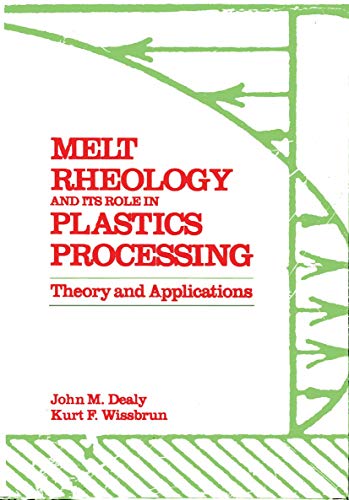Articoli correlati a Melt Rheology and Its Role in Plastics Processing:...

Le informazioni nella sezione "Riassunto" possono far riferimento a edizioni diverse di questo titolo.
Le informazioni nella sezione "Su questo libro" possono far riferimento a edizioni diverse di questo titolo.
- EditoreSpringer
- Data di pubblicazione2013
- ISBN 10 1461597404
- ISBN 13 9781461597407
- RilegaturaCopertina flessibile
- Numero di pagine692
Compra nuovo
Scopri di più su questo articolo
Spese di spedizione:
GRATIS
In U.S.A.
I migliori risultati di ricerca su AbeBooks
Melt Rheology and Its Role in Plastics Processing: Theory and Applications by Wissbrun, K. [Paperback ]
Descrizione libro Soft Cover. Condizione: new. Codice articolo 9781461597407
Melt Rheology and Its Role in Plastics Processing: Theory and Applications
Descrizione libro Condizione: New. Codice articolo ABLIING23Mar2716030038614
Melt Rheology and Its Role in Plastics Processing: Theory and Applications
Descrizione libro Condizione: New. Book is in NEW condition. Codice articolo 1461597404-2-1
Melt Rheology and Its Role in Plastics Processing: Theory and Applications
Print on DemandDescrizione libro Condizione: New. PRINT ON DEMAND Book; New; Fast Shipping from the UK. No. book. Codice articolo ria9781461597407_lsuk
Melt Rheology and Its Role in Plastics Processing
Descrizione libro Taschenbuch. Condizione: Neu. This item is printed on demand - it takes 3-4 days longer - Neuware -This book is designed to fulfill a dual role. On the one hand it provides a description of the rheological behavior of molten poly mers. On the other, it presents the role of rheology in melt processing operations. The account of rheology emphasises the underlying principles and presents results, but not detailed deriva tions of equations. The processing operations are described qualita tively, and wherever possible the role of rheology is discussed quantitatively. Little emphasis is given to non-rheological aspects of processes, for example, the design of machinery. The audience for which the book is intended is also dual in It includes scientists and engineers whose work in the nature. plastics industry requires some knowledge of aspects of rheology. Examples are the polymer synthetic chemist who is concerned with how a change in molecular weight will affect the melt viscosity and the extrusion engineer who needs to know the effects of a change in molecular weight distribution that might result from thermal degra dation. The audience also includes post-graduate students in polymer science and engineering who wish to acquire a more extensive background in rheology and perhaps become specialists in this area. Especially for the latter audience, references are given to more detailed accounts of specialized topics, such as constitutive relations and process simulations. Thus, the book could serve as a textbook for a graduate level course in polymer rheology, and it has been used for this purpose. 692 pp. Englisch. Codice articolo 9781461597407
Melt Rheology and Its Role in Plastics Processing
Descrizione libro Condizione: New. Codice articolo 4200914
Melt Rheology and Its Role in Plastics Processing: Theory and Applications
Descrizione libro Condizione: New. New! This book is in the same immaculate condition as when it was published. Codice articolo 353-1461597404-new
Melt Rheology and Its Role in Plastics Processing: Theory and Applications
Descrizione libro Condizione: New. Codice articolo I-9781461597407
Melt Rheology and Its Role in Plastics Processing : Theory and Applications
Descrizione libro Taschenbuch. Condizione: Neu. Druck auf Anfrage Neuware - Printed after ordering - This book is designed to fulfill a dual role. On the one hand it provides a description of the rheological behavior of molten poly mers. On the other, it presents the role of rheology in melt processing operations. The account of rheology emphasises the underlying principles and presents results, but not detailed deriva tions of equations. The processing operations are described qualita tively, and wherever possible the role of rheology is discussed quantitatively. Little emphasis is given to non-rheological aspects of processes, for example, the design of machinery. The audience for which the book is intended is also dual in It includes scientists and engineers whose work in the nature. plastics industry requires some knowledge of aspects of rheology. Examples are the polymer synthetic chemist who is concerned with how a change in molecular weight will affect the melt viscosity and the extrusion engineer who needs to know the effects of a change in molecular weight distribution that might result from thermal degra dation. The audience also includes post-graduate students in polymer science and engineering who wish to acquire a more extensive background in rheology and perhaps become specialists in this area. Especially for the latter audience, references are given to more detailed accounts of specialized topics, such as constitutive relations and process simulations. Thus, the book could serve as a textbook for a graduate level course in polymer rheology, and it has been used for this purpose. Codice articolo 9781461597407
Melt Rheology and Its Role in Plastics Processing: Theory and Applications
Descrizione libro Paperback / softback. Condizione: New. This item is printed on demand. New copy - Usually dispatched within 5-9 working days. Codice articolo C9781461597407

